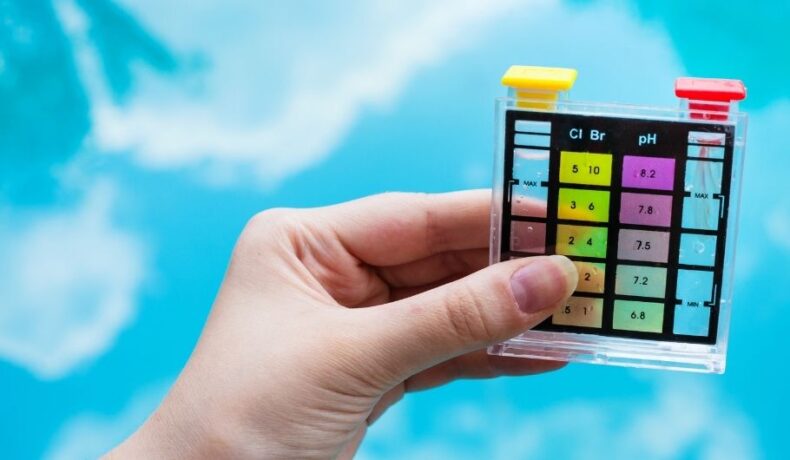Finally, you’ve managed to gather all of the necessary components for your first hydroponic grow; lighting, seeds, nutrients, maybe even a grow tent or your very own DIY structure. But there’s one aspect that’s causing some anxiety for you – being able to maintain the pH of your hydroponic grow.
Let’s be honest, chemistry isn’t exactly everyone’s strong suit and honestly, most people find this part of growing plants to be both tedious and nerve-racking.
Be that as it may, pH maintenance simply cannot be overlooked. You can have the most expensive equipment at hand, but if you don’t make the effort to set and maintain optimum pH levels for your crop, you’ll be left disappointed with your results. What’s more, your efforts will be for nothing.
In this article, you’ll learn all there is to know about pH for hydroponics – what it is, why it’s important, and most importantly, how to maintain your crops’ pH levels.
In addition to the above, we’ll provide you with a chart outlining the optimal pH levels for a range of common crops.
Table of Contents
What Is pH For Hydroponics?
pH is a scale that measures how acidic or basic (alkaline) a solution is at the time of reading.
The scales range goes from 0-14 with 7 being neutral. Anything less than 7 indicates acidity and anything more than 7 indicates alkalinity.
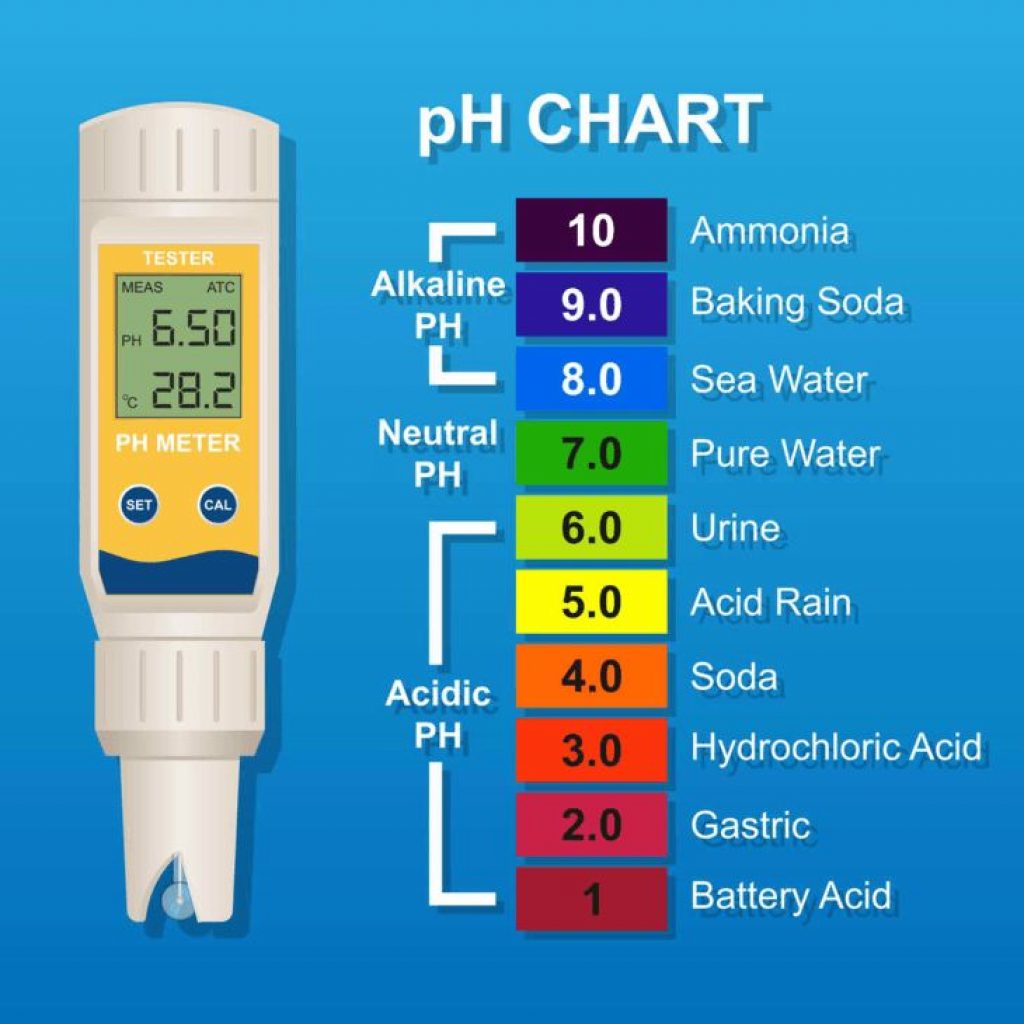
Why Is pH For Hydroponic Systems So Important?
Having the correct pH level as part of your hydroponic system is essential as it greatly influences the availability of nutrients. As such, it is important that the optimum range be maintained for the best growth results.
What Is The Best pH For Hydroponics?
According to a research paper – A low-cost nutrient formulation with a buffer for
simplified hydroponics systems – the most suitable pH range for plants is 5.8 – 6.5. But bear in mind, different crops will grow best at varying pH levels.
What Happens If pH Levels Are Too Low?
You’ll recall that a low pH means that acidity is present. This will be anything from 0-7 on the pH scale.
While most plant species can in fact survive and even thrive in a slightly acidic environment, a solution that is too acidic can have disastrous consequences for your crop.
But why? Well, as previously mentioned, the pH of a solution greatly influences the availability of nutrients in a solution. Sure, some nutrients will still be present within a very acidic pH range, but others will be ‘blocked’ from entering the plant.
The result – toxicity will set in. Your plant/crop have have too many certain nutrients – such as iron or manganese – while having too few other nutrients, such as calcium, magnesium, and phosphorous.
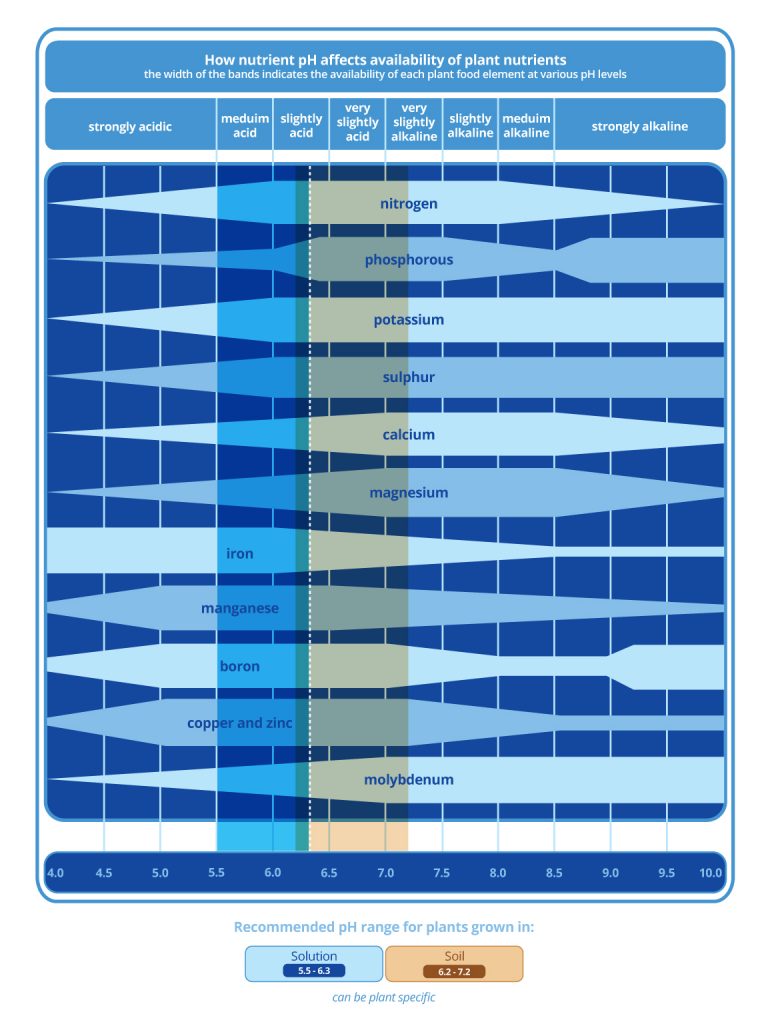
Source:Blue Lab
Plant Symptoms at Low pH levels
Simply knowing the consequences of low pH levels within your hydroponic setup is not enough. You also need to know what warning signs to look out for.
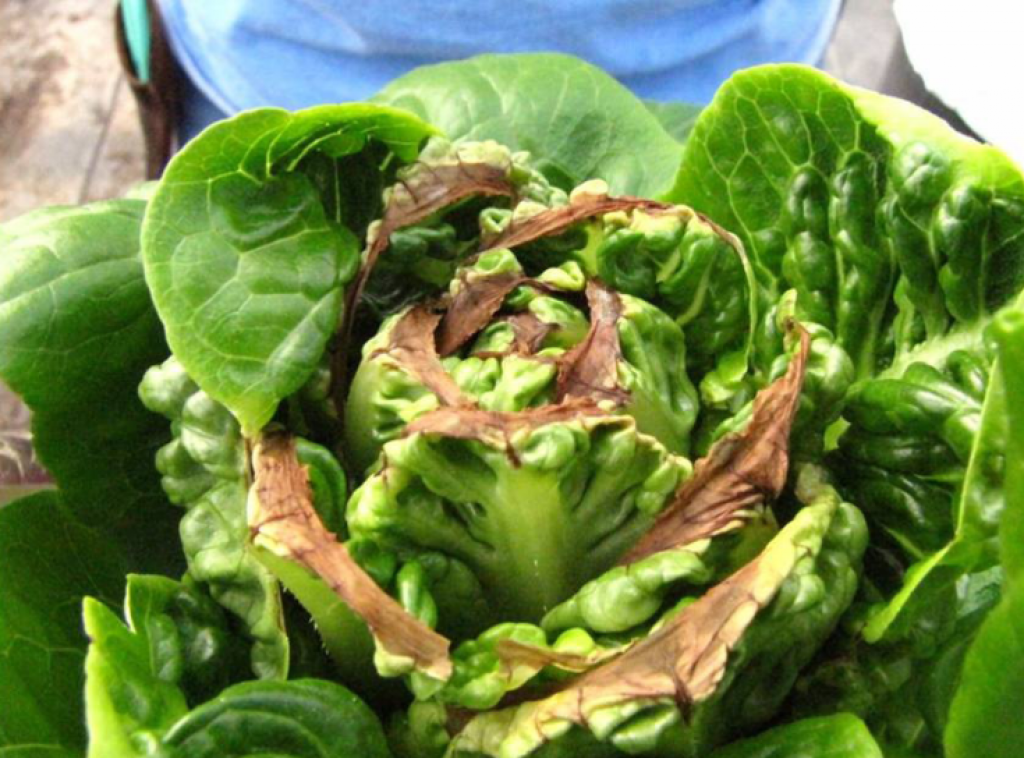
Source: LaptrinhX
The following are examples of common signs associated with low pH levels:
- Leaf necrosis
- Blossom end rot
- Brown spots on the leaves
- Leaf chlorosis
- Stunted growth
- Leaf tip burn
- Withered, stunted or twisted leaves
- Dark green leaves tinged with red, bronze or purple
How Do I Maintain The Correct pH Levels For Hydroponics?
As previously mentioned, maintaining the correct pH levels for your hydroponic grow is vital. Without it, your plants will not have access to the nutrients they require to flourish.
In this section we’re going to delve into the steps you need to take to manage your pH levels effectively.
Soil VS Hydroponic Culture
First and foremost, when it comes to maintaining pH, there is a massive difference between soil and hydroponic (soilless) culture. In soil culture, soil acts as a buffer and helps to maintain both a pH and EC suitable for plant growth.
This is not the case in hydroponic growing as the buffer is absent. As such, it’s important to maintain an environment suitable for plant growth – this is done artificially.
pH Management
When measuring your pH solution, you’ll require a pH meter. In order to calibrate your meter, you’ll need a pH buffer solution. These usually come in a pH of 4, 7, or 10.
Steps For pH Management
The following steps should be performed for pH management:
- First, set the desired EC value of your solution. (see the below section on EC management for details)
- Calibrate your pH meter probe using the buffer solution.
- Make sure your nutrient solution is stirred up and allow the reading to stabilize. This may take take a couple of minutes.
- If the pH reading is high, add the following elements: phosphoric acid, citric acid, vinegar or pH down. Be sure to add them slowly and wait several minutes before adding more. Repeat until the pH reaches the optimum range.
- If the pH is low, add potassium hydroxide, potassium carbonate or a pH up product. Again, be sure to do so slowly and repeat until the pH reaches the optimum range.
- Clean the probe and store in cleaning fluid.
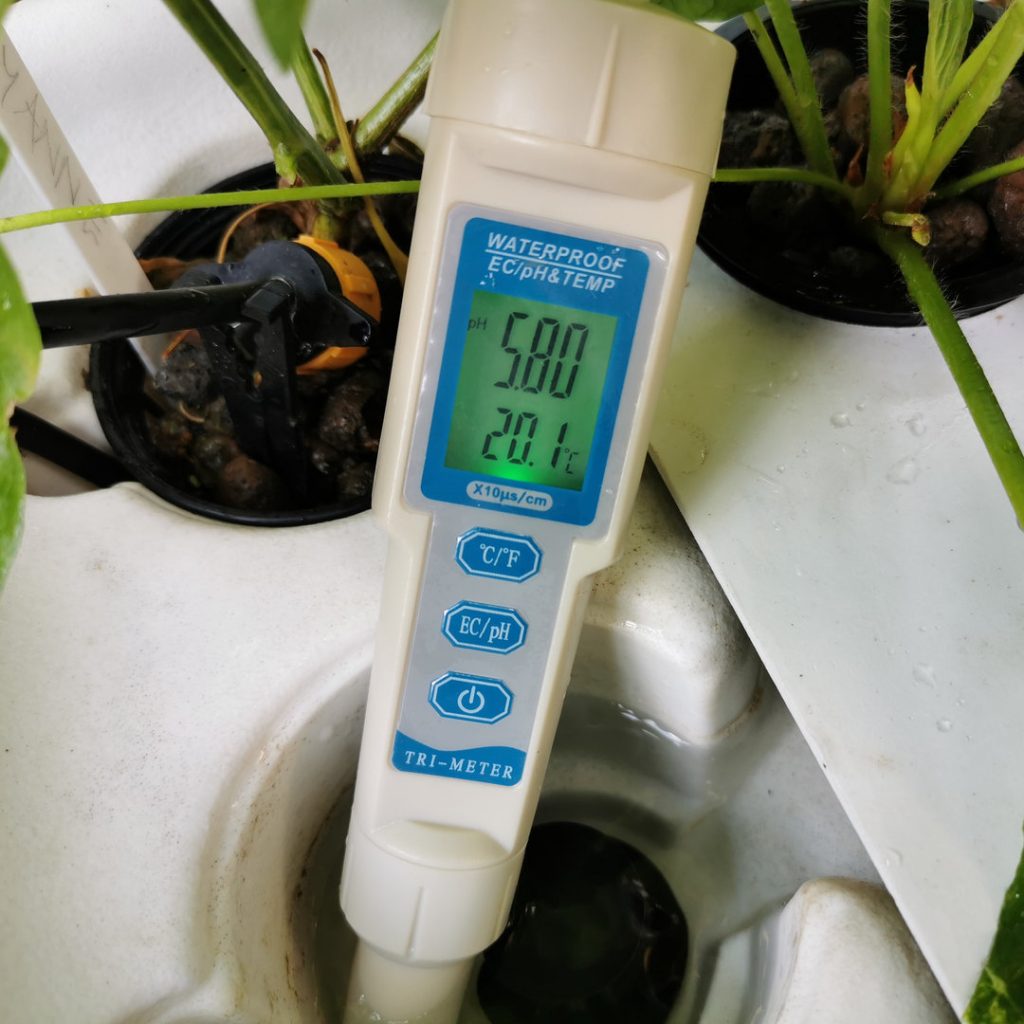
Source: Supragarden
Eletrical Conductivity (EC) Management
You may have already come across electrical conductivity in our article – DIY Hydroponic Nutrients (How To Make Your Own Formula).
If not – electrical conductivity measures the concentration of the nutrient solution based on its ability to conduct electricity. Pure water does not actually conduct electricity, only water with solutes (elements) added to it is capable of doing that.
In order for you to measure the electrical conductivity of a solution, you’ll need:
- An EC meter
- A buffer solution which you will use to calibrate the EC meter
This special meter measures the electricity conducted by the nutrient solution, which is directly related to the level of total dissolved solutes in the solution.
The scale is commonly expressed as millimhos (mMhos)or millisiemens (mS).
Steps For EC Management
The following steps should be performed for EC management:
- Fill your nutrient tank with tap or filtered water and add fertilizer. Base the quantity that you use on the manufacturer recommendation.
- Calibrate your EC meter probe using the buffer solution.
- Make sure the nutrient solution is stirred up and allow the reading to stabilize – this may take a couple of minutes.
- If the reading is higher than the optimum level, dilute your solution by adding more water, then repeat step 3.
- If the reading is below the optimum level, add nutrient concentrate until the optimum level is reached by repeating step 3.
- Rinse your probe in tap water and store in the probe-cleaning fluid.
Important Maintenance Info
- Always check your ph after getting your EC reading into the optimum range.
- Check your pH and EC daily, if possible.
- Make sure to check your pH and EC at the same time of day.
- A water temperature of 72 – 75 °F (22.2 – 23.8 °C) is optimal.
pH Chart For Hydroponic Crops
The following table provides the optimum range of electrical conductivity (EC) and pH values for hydroponic crops.
| Crops | pH | EC (mS/cm) |
| Asparagus | 6.0 – 6.8 | 1.4 – 1.8 |
| African Violet | 6.0 – 7.0 | 1.2 – 1.5 |
| Basil | 5.5 – 6.0 | 1.0 – 1.6 |
| Bean | 6.0 | 2.0 – 4.0 |
| Banana | 5.5 – 6.5 | 1.8 – 2.2 |
| Broccoli | 6.0 – 6.8 | 2.8 – 3.5 |
| Cabbage | 6.5 – 7.0 | 2.5 – 3.0 |
| Celery | 6.5 | 1.8 – 2.4 |
| Carnation | 6.0 | 2.0 – 3.5 |
| Courgettes | 6.0 | `1.8 – 2.4 |
| Cucumber | 5.0 – 5.5 | 1.7 – 2.0 |
| Eggplant | 6.0 | 2.5 – 3.5 |
| Ficus | 5.5 – 6.0 | 1.6 – 2.4 |
| Leek | 6.5 – 7.0 | 1.4 – 1.8 |
| Lettuce | 6.0 – 7.0 | 1.2 – 1.8 |
| Marrow | 6.0 | 1.8 – 2.4 |
| Okra | 6.5 | 2.0 – 2.4 |
| Pak Choi | 7.0 | 1.5 – 2.0 |
| Peppers | 5.5 – 6.0 | 0.8 – 1.8 |
| Parsley | 6.0 – 6.5 | 1.8 – 2.2 |
| Rhubarb | 5.5 – 6.0 | 1.6 – 2.0 |
| Rose | 5.5 – 6.0 | 1.5 – 2.5 |
| Spinach | 6.0 – 7.0 | 1.8 – 2.3 |
| Strawberry | 6.0 | 1.8 – 2.2 |
| Sage | 5.5 – 6.5 | 1.0 – 1.6 |
| Tomato | 6.0 – 6.5 | 2.0 – 4.0 |
pH Guide for Hydroponics – Oklahoma State University
Final Thoughts
By now you should have both a greater appreciation and understanding of the role that ph maintenance plays in your hydroponic system.
Again, we understand that this isn’t always the most enjoyable part of the growing process but it’s vital that you come to grips with this aspect of hydroponics.
In fact, after a while, you’ll find that pH maintenance will become second nature to you – you may even begin to enjoy it. After all, nurturing your plants by making sure that they grow in a healthy and happy environment is incredibly fulfilling.
Further Reading
You’re probably going down a bit of a rabbit hole with hydroponics, so why stop now?
Here are some other helpful articles for you to have a look at:

